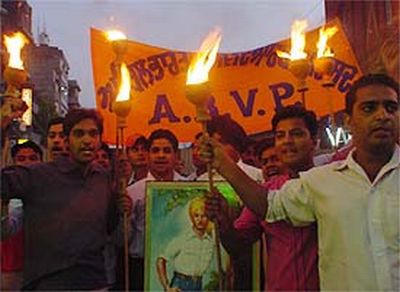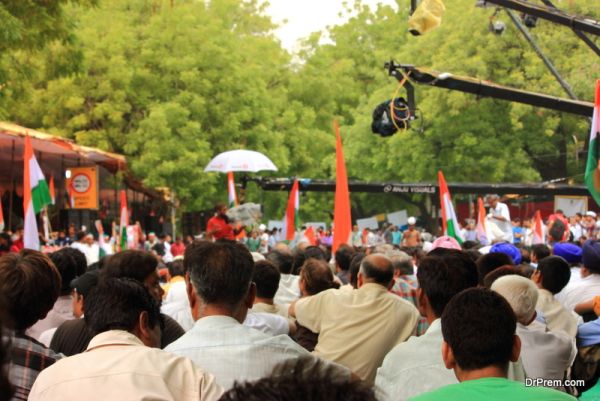Whenever any agitation arises, huge damage to public property is being done by the people. Burning of trains, stone pelting on government authorities has become a common phenomenon and the government chooses to remain a silent spectator. Destruction of public property, or vandalism, has become a popular medium for airing grievances. Lack of fear and respect for the public property are the two possible reasons for such acts of arson.
Damage to public property act,1984,was implemented by the constitution but it is seldom followed.According to this act, causing to public property is condemnable and punishment can be imprisonment up to 10 years or paying the cost that has incurred.
But this his act failed to curtail the growing menace as authorities were unable to punish the vandals owing to a poor understanding of their duties and lack of efficient staff to pursue the investigation in such matters. The officials were ineffective to bring the perpetrators who were responsible for such vandalism in the country.
Persons who willfully cause damage to public property should be made liable to compensate for the damage. If individuals are difficult to trace, then political parties, groups or organization who are indulged in this should be made vicariously liable to pay the amount because such violent and indecent behavior will not be tolerated in the Indian society.
PUDR set an example for this when it condemned ABVP and RSS for an attempt at vandalizing in Delhi University in the year 2008. Read on to find out what happened and how the University Community took meaningful and constructive action against the same.
PUDR condemns the vandalism of ABVP and RSS in Delhi University

The People’s Union for Democratic Rights has condemned the incident of vandalism by Akhil Bharatiya Vidyarthi Parishad goons (ABVP, student wing of the RSS) in Delhi University, in which members of the press community were also made victims.
The University Community, an independent group of students and teachers of Delhi University, organized a meeting on “Communalism, Fascism and Democracy: Rhetoric and Reality” on 6th November 2008 at Room No. 22 Arts Faculty. It did not come as a surprise that right-wing forces would be opposed to any meaningful discussion on these issues.
What actually happened?
As the Chair of the meeting, SAR Geelani (lecturer at Zakir Husain College, University of Delhi), came inside the room and took his seat, one of the ABVP members came and spat on his face twice. It was then that we realized that this was a planned attempt to disrupt the public meeting – ABVP goondas were sitting inside the room and they rose to hurl abuses at the participants and physically attack them. DUSU President Nupur Sharma (of ABVP) entered the room and declared that SAR Geelani, a lecturer of this University, could not speak in the University! This, when we had taken due permission from the University authorities to conduct the meeting.
The ABVP members did not just stop at vandalism. An attacked was launched at the women students and participants, broke the microphone and hurled chairs. They also manhandled media persons who were covering the meeting. Two journalists from Tehelka and Mail Today, who were speakers at the meeting, were threatened by ABVP. The mother of one of the media persons who were present had to leave the venue because she was terrorized by the goons. At this point, the Pro-Vice-Chancellor and the Proctor called one of the organizers and told him that the meeting could not go on because it was creating a ‘law and order’ problem. Who did the University administration side with? ABVP.
What action did the PUDR take against vandalism?
It was the courage and fortitude of the audience who insisted on continuing the meeting. The ABVP goons were pushed out of the room and the meeting continued behind closed doors. ABVP did not stop there. In the presence of a large contingent of Delhi Police, and we dare say with their permission, they threw stones at the room, broke all the window panes, tried to break the doors and continued abusing. Goli maaro saalon ko, Pakistan Murdabad, Vande Mataram were some of the better ones. SAR Geelani, in particular, was targeted. However, they could not scare us and stop the meeting from concluding successfully.
The University Community, the organizer of the meeting alleged that this was not the first effort of ABVP to snatch all the democratic space available to it in the University. Last year, the faculty members and students of the History Department were targeted. Only because of a text in their syllabus. The same goons once attacked the right to study history texts. And now, they also attacked the right to hold meetings and discussions.
The imminent threat
During a meeting on communalism and fascism, it witnessed the threat and danger. This was posed by communal and fascist forces to the secular and democratic fabric of our country. The parent organization of ABVP and the politics espoused by them is responsible for the widespread attack on minorities across the country. It is they who were responsible for the genocide in Gujarat and for spreading the politics of hate and fear. If we remain silent today, we will lose whatever little space that is left to us in the University. Do we need to take permission from ABVP to hold a meeting in the University? Who does the University administration and Delhi Police support in the fight against fascism?
It has called upon the entire University community to protest against this assault on academic freedom and democratic rights. The University community had organized a protest march on November 07 at the University. The march began at 11:00 a.m. at Vivekananda statue, Arts Faculty.
It has also demanded:
1. The University administration should lodge an FIR against ABVP members. Especially, against persons like Nupur Sharma, Vikas Dahiya, Desh Ratan, Sonu Singh, and Ashutosh.
2. Time-bound inquiry into this act of vandalism and goondaism and action against the people found guilty.
3. To give us assurance that future public meetings on similar issues will not be disrupted by these goons.
However, the question that protestors, spectators, and government officials often sideline is: Are street protests actually effective? Is there no other way to persuade the law to take action against such crimes? Read on to know how street protests are useful, yet insufficient at the same time.
The Pros and Cons of a Street Protest
Street protesting is a form of public demonstration to show their anger, agony and agitation against the actions of the government in any state or country. Street protesters usually use handmade placards and sandwich boards to help their message reach the citizens and the government as well. The populated locations and the locations near to the government offices are the favorite destinations for street protest.
The Cons
The unwanted protests may hamper the people who do not take an active part in it. It causes traffic disturbances, loss of public property, and so on. Any street protest requires a few battalions of the police force to control any expected damage. So it is more or less wasting the valuable time of public and police.
There is a healthy chance of the political parties taking advantage of the street protests and paralyze the constitution. The political parties may try to play their politics by making a peaceful protest violent and harm the objective of the protest.
The ruling government always requires complete support from society to perform better towards the growth and stability of the country. A country needs continuous support from different ethnic groups and forces dwelling fellow countrymen. Any such protest may hamper their unity and lead the society towards a huge disturbance.
What can be done to counter the cons?
People should always try and find a smooth legal channel to represent their agitations so that it does not hamper any individual, law, and order of the country. The freedom of expression can also be achieved by adhering to the framework of the constitution and it would be a more efficient way to protest.
Most of the street protests take place in developing countries. It has no longer been an effective way to make a positive impact on the government. If the developing countries want to turn into developed ones, they need to learn to make political innovations in their countries. The street protests would never allow them to get strengthened politically and represent themselves as developed countries globally.




